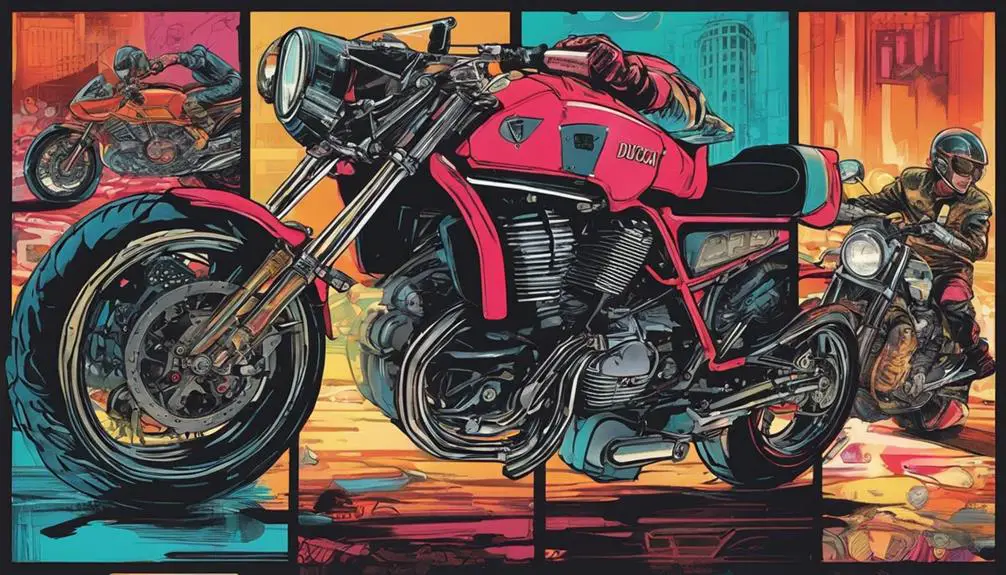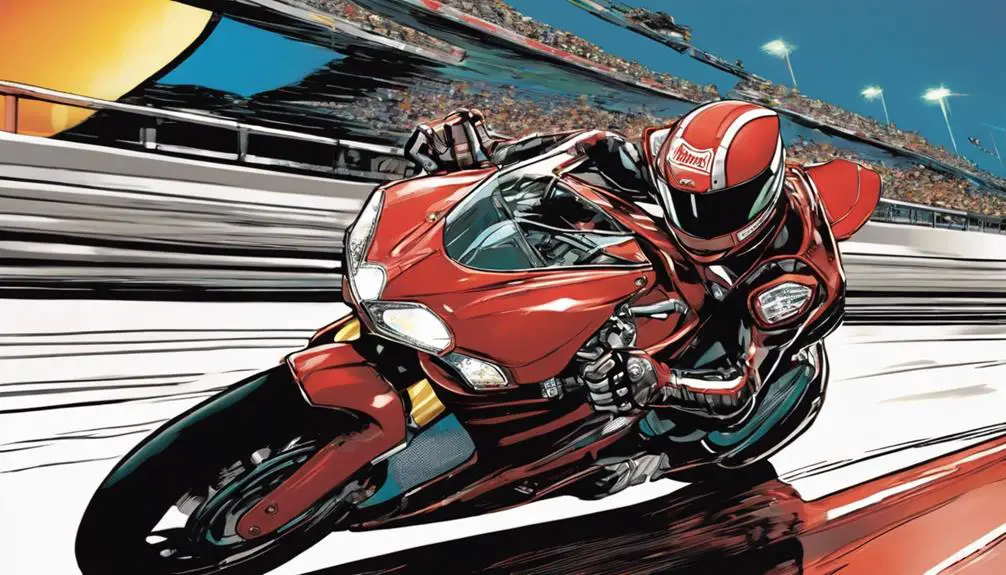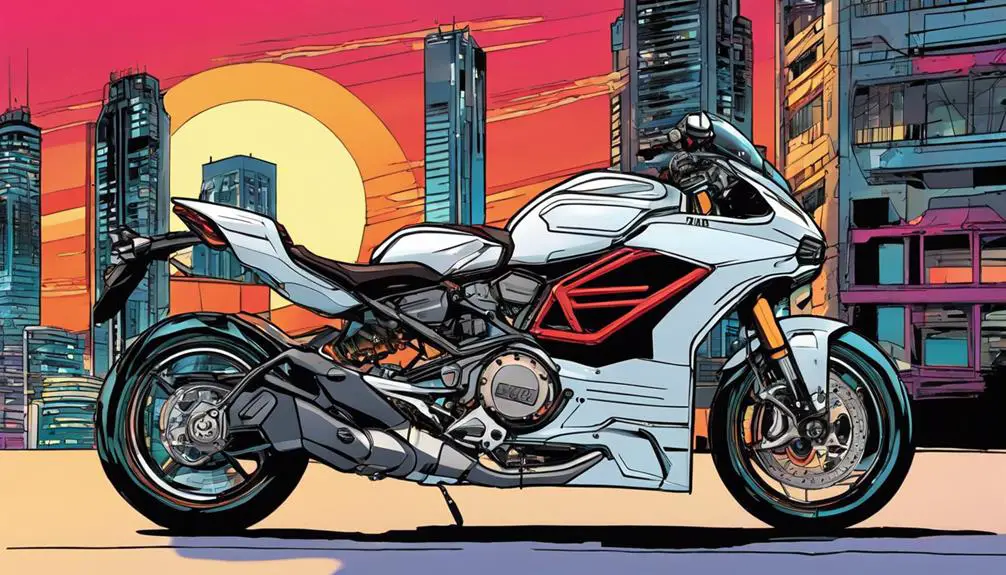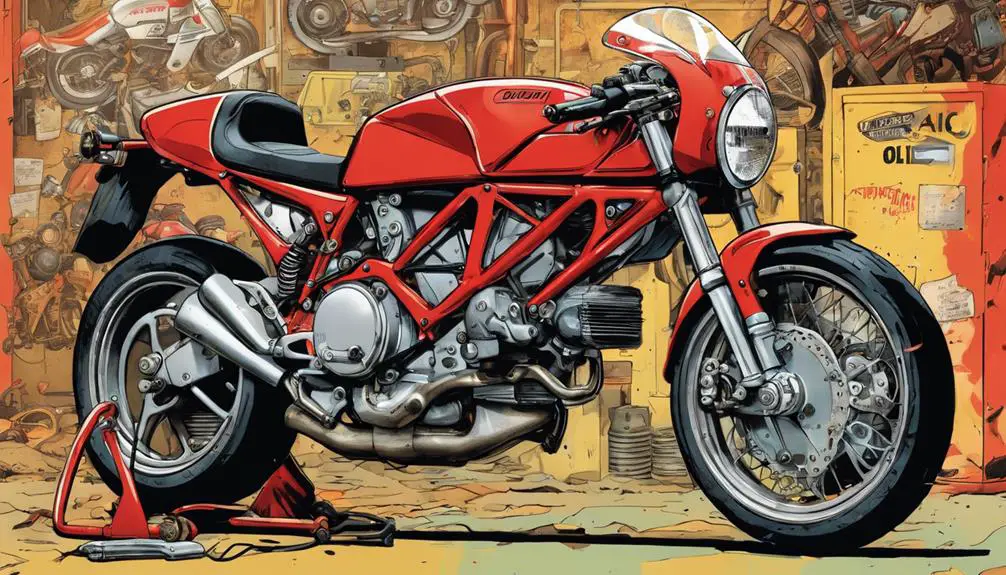When you think about Ducati motorcycles, it's clear that their specifications have transformed considerably over the decades. From the innovative Desmodromic valve system introduced in the 1970s to the advanced electronics in today's models, each era reflects a blend of engineering prowess and performance enhancement. You might wonder how these changes have shaped the riding experience and influenced the motorcycle market. As we explore the key milestones in Ducati's evolution, you'll begin to see the intricate relationship between technology and design that defines these iconic machines.
Key Takeaways
- Early Ducati models featured lightweight frames and efficient engines, emphasizing performance and style in the late 1940s.
- The 1970s introduced the Desmodromic valve system and powerful v-twin engines, solidifying Ducati's racing dominance.
- Key models like the Ducati 851 and 750 F1 in the 1980s showcased liquid-cooled engines and aggressive designs, enhancing rider experience.
- The 1990s iconic 916 series revolutionized sport motorcycles with a trellis frame, powerful L-twin engine, and stunning aesthetics.
Early Ducati Models

Ducati's early models laid the foundation for its reputation in the motorcycle industry, showcasing innovative engineering and distinctive design. You can feel the spirit of freedom as you ride these machines, which were built for those who crave adventure and authenticity. The 98 and 125 models, introduced in the late 1940s, set the stage with their lightweight frames and efficient engines, making them accessible to a wide range of riders.
These bikes weren't just about getting from point A to point B; they embodied a lifestyle of exploration and excitement. The early Ducati designs emphasized performance without sacrificing style, allowing you to express your individuality on the open road.
As you explore the specifications of these models, you'll appreciate the attention to detail that went into each component, from the robust engines to the sleek bodywork. They invited a sense of rebellion against ordinary transportation, urging you to break free from the mundane.
Each ride becomes a declaration of your desire for liberation, a nod to the innovative spirit that Ducati has always championed. Embrace that heritage, and let it fuel your passion for the ride ahead.
The 1970s: A Performance Revolution
In the 1970s, Ducati transformed the motorcycle landscape with groundbreaking engine innovations and design trends that pushed performance boundaries.
You'll see how racing achievements influenced their engineering, making Ducati a name synonymous with speed and style.
Get ready to explore the features that defined this revolutionary decade.
Engine Innovations and Developments
As the 1970s unfolded, motorcycle enthusiasts witnessed a remarkable performance revolution fueled by Ducati's innovative engine technologies. You're stepping into a world where power and precision collide, as Ducati introduced the iconic Desmodromic valve system. This engineering marvel allowed for faster valve actuation, enhancing responsiveness and giving you the exhilarating ride you crave.
Ducati's engineers didn't stop there. They focused on lightweight designs, utilizing advanced materials to reduce weight while maintaining strength. You'll appreciate how these innovations translated to quicker acceleration and nimble handling, making each ride feel like an extension of your own spirit.
The introduction of the 750 Sport and the legendary 900SS showcased Ducati's commitment to performance. With powerful v-twin engines that roared to life, you found yourself liberated from the mundane. The sound, the feel, and the sheer thrill of the ride connected you to the road in a way that few motorcycles could.
In this era, Ducati didn't just build bikes; they crafted experiences that ignited your passion for freedom and adventure. This was a time when innovation paved the way for a new breed of motorcycle enthusiasts ready to embrace the open road.
Racing Influence and Achievements
The 1970s marked a turning point in motorcycle racing, with Ducati's dominance on the track showcasing the raw power and innovative design that captivated both riders and fans alike. You can feel the thrill as Ducati released its revolutionary V-twin engines, which offered unmatched torque and acceleration. This wasn't just about speed; it was about the art of racing.
Ducati's success wasn't just in the numbers; it was the spirit of the brand that resonated with you. With legendary riders like Paul Smart and Mike Hailwood pushing the limits, you witnessed firsthand how Ducati motorcycles transformed the racetrack into a stage for passion and freedom.
The iconic 750 Imola, for example, didn't just win races; it defined an era. As you cheered for Ducati, you weren't just rooting for a motorcycle; you were embracing a movement that celebrated individuality and the relentless pursuit of performance.
The 1970s solidified Ducati's place in racing history, and as a fan, you couldn't help but feel liberated, riding the waves of innovation that defined this exhilarating decade. You knew you were part of something extraordinary.
Design Trends and Features
Ducati motorcycles of the 1970s showcased a striking blend of aerodynamic design and powerful engineering, setting new benchmarks for performance and style in the motorcycle world. You can feel the spirit of liberation in every curve and contour, as these machines were built to fly down the open road and dominate the racetrack. The iconic 750 Super Sport, with its sleek lines and vibrant color schemes, wasn't just a bike; it was a statement of freedom.
During this era, Ducati introduced lightweight frames and powerful engines, making their motorcycles not only fast but also agile. The use of innovative materials, like fiberglass for fairings, reduced weight and enhanced aerodynamics. High-performance features like twin-cylinders and advanced suspension systems became standard, offering you unmatched handling and responsiveness.
The 1970s also brought a sense of style that transcended mere functionality. Ducati motorcycles became symbols of rebellion and individualism, appealing to riders who sought to express their identity through speed and design. Riding one of these beauties gave you a visceral experience, combining thrill with the artistry of engineering. It was a decade that truly revolutionized motorcycle culture, igniting your passion for the ride.
Evolution in the 1980s

In the 1980s, Ducati kicked off a transformation that would shape its future.
You'll see key models released, engine innovations introduced, and design aesthetics that turned heads.
This era marked a significant shift in the brand's identity, setting the stage for what was to come.
Key Models Released
During the 1980s, Ducati rolled out several key models that greatly shaped its identity and reputation in the motorcycle industry.
You might remember the Ducati 750 F1, which debuted in 1985. This bike, with its distinctive design and powerful performance, not only captured hearts but also became a symbol of the brand's racing heritage.
Then there's the Ducati 851, launched in 1987, which took the world by storm with its groundbreaking liquid-cooled engine. This model marked a significant shift in Ducati's approach to performance, pushing the boundaries of what a sportbike could achieve.
You can't overlook the impact of the Ducati 900SS, either. Introduced in 1988, it blended timeless classic styling with modern performance, creating a motorcycle that wasn't just about speed but also about freedom and expression.
These models didn't just add to the lineup; they revolutionized your experience as a rider, letting you embrace the open road with confidence and style.
The 1980s were a defining decade for Ducati, solidifying its place in motorcycle history.
Engine Innovations Introduced
As the 1980s progressed, Ducati introduced a series of engine innovations that dramatically enhanced performance and set new benchmarks for sportbikes. One of the standout developments was the introduction of the L-twin engine configuration, which offered a perfect balance of power and weight. This design not only improved throttle response but also provided a thrilling riding experience, making you feel alive on the open road.
Ducati also embraced the concept of desmodromic valve actuation during this era, ensuring precise control over valve timing. This innovation eliminated the need for conventional springs, allowing for higher RPMs and better performance across the power band. With these advancements, you could express your passion for speed and agility like never before.
Additionally, the introduction of liquid cooling systems helped regulate engine temperatures, boosting reliability and longevity. You could ride longer and harder without fear of overheating.
These engine innovations reflected Ducati's commitment to pushing boundaries, giving you the freedom to explore your limits. With each twist of the throttle, you experienced a sense of liberation, knowing that you were riding a machine built for pure exhilaration.
Design Aesthetic Changes
Ducati's design aesthetic evolved dramatically in the 1980s, embracing a bold and aggressive look that captured the spirit of performance and speed. You could feel the adrenaline rush just by gazing at the sharp lines and streamlined forms of these motorcycles. The iconic Ducati 851, introduced in 1987, epitomized this change with its distinctive fairings and vibrant color schemes, appealing to riders who craved both style and substance.
During this decade, Ducati moved away from the more conservative designs of the past. The emphasis shifted to angular shapes and aerodynamic profiles, reflecting a growing desire for liberation and expression. You might remember how the iconic trellis frame became a hallmark of Ducati's engineering, not just for its functionality but also for its striking visual impact. These motorcycles weren't just machines; they embodied a lifestyle of freedom and rebellion.
As you embraced the open road, riding a Ducati from the 1980s felt like a declaration of independence. The designs invited you to break boundaries and chase your dreams, making every ride an exhilarating journey toward liberation and self-discovery.
Ducati's Iconic 916 Series
The 916 series revolutionized sport motorcycles with its stunning design and powerful performance. You'll instantly recognize its aggressive lines, which blend form and function seamlessly. This series, first introduced in the mid-1990s, redefined what a sport bike could be. With its trellis frame and distinctive single-sided swingarm, the 916 isn't just a bike; it's a statement of freedom and exhilaration.
Powered by a potent L-twin engine, this series delivers adrenaline-pumping acceleration that connects you with the road. You can feel the raw energy coursing through the chassis, allowing for nimble handling and precise cornering. It's designed for those who crave the thrill of the ride, liberating you from the mundane.
The 916 series isn't just about performance; it's a tribute to the spirit of motorcycling. It invites you to embrace the open road, to explore without limits. When you ride a 916, you're not merely getting from point A to B; you're initiating a journey of self-discovery.
Experience the 916, and you'll understand why it remains a benchmark in the world of sport bikes, embodying the essence of true liberation.
Advancements in the 2000s

In the 2000s, you'll notice significant strides in Ducati's engineering and design.
The brand introduced powerful engine enhancements and cutting-edge technology that transformed the riding experience.
Let's explore how these advancements shaped the motorcycles you see today.
Engine Performance Enhancements
Enhancing engine performance through advanced engineering, Ducati made significant strides in the 2000s, introducing innovations that boosted power and efficiency. You experienced the thrill of riding a Ducati, knowing that beneath you was a machine optimized for maximum performance. With each model, Ducati pushed the boundaries of what's possible, giving you that exhilarating sense of liberation.
Here are four key enhancements you'd appreciate:
- Desmodromic Valve System: This unique design allowed for precise control of valve timing, improving throttle response and rev limits.
- Fuel Injection Technology: The switch to electronic fuel injection improved fuel atomization, enhancing combustion efficiency and reducing emissions.
- Lighter Materials: By incorporating lightweight components, such as aluminum and carbon fiber, Ducati reduced overall weight, increasing power-to-weight ratios.
- Variable Length Intake Systems: These systems optimized air intake at different RPMs, providing a broader power band and better performance across various speeds.
These advancements not only refined the riding experience but also guaranteed that every twist of the throttle felt like pure freedom. Immerse yourself in the world of Ducati, where power meets passion.
Technological Innovations Implemented
Ducati revolutionized motorcycle design in the 2000s by integrating cutting-edge technologies that elevated performance and rider engagement. You experienced this transformation through innovations like the Ducati Traction Control (DTC) system, which provided you with unprecedented control over your ride. This technology adjusted power delivery in real time, empowering you to release the full potential of your machine while maintaining confidence on the road and track.
Another significant advancement was the introduction of the Testastretta engine, which enhanced torque and responsiveness. You felt the thrill as this engine delivered power seamlessly, making every ride exhilarating. Additionally, the incorporation of the Ducati Data Analysis (DDA) system allowed you to analyze your performance, giving you insights that could refine your riding technique.
Ducati also embraced lightweight materials, like the use of aluminum and carbon fiber, helping to improve the overall agility of the motorcycles. These innovations combined to create a unique riding experience, liberating you from the mundane and connecting you with the thrill of the open road.
In the 2000s, Ducati didn't just build motorcycles; they crafted machines that set you free.
Design Evolution Highlights
The 2000s marked a pivotal era for motorcycle design, where sleek lines and aggressive styling converged to create visually stunning machines that captivated riders like you. Ducati embraced this evolution with a fierce commitment to innovation, leading to some iconic models that redefined motorcycling aesthetics.
Here are four highlights of Ducati's design evolution during this dynamic decade:
- Monster Series: The introduction of the Monster 696 in 2008 showcased a minimalist design that emphasized a raw, naked look, appealing to the urban rider's desire for freedom.
- Superbike Aesthetics: The 1098, launched in 2007, featured a bold, aerodynamic silhouette, blending performance with beauty, making it a track and street favorite.
- Artful Engineering: The use of lightweight materials like aluminum and carbon fiber not only enhanced performance but also contributed to the stunning visual appeal of their bikes.
- Iconic Color Schemes: Ducati's signature red, along with striking graphics, symbolized passion and power, embodying the spirit of liberation that every rider craves.
These advancements solidified Ducati's reputation as a leader in motorcycle design, inviting you to experience the thrill of the open road.
The Impact of Technology
Technology has transformed how you experience riding, making motorcycles smarter, safer, and more efficient than ever before. You're not just straddling a machine; you're harnessing a powerful blend of engineering and innovation that liberates your journey.
Modern Ducati motorcycles are equipped with advanced electronics that enhance performance and control, allowing you to tackle any road with confidence. Imagine the thrill of precise traction control adjusting power to your rear wheel, guaranteeing you maintain grip even in challenging conditions. With ride-by-wire throttle systems, you feel an immediate connection to your bike, responding intuitively to every twist of the wrist.
Safety features like cornering ABS and advanced braking systems empower you to push your limits while keeping you grounded. You can let go of worries and embrace the freedom of the open road, knowing technology has your back.
Fuel injection and lightweight materials boost efficiency and agility, transforming every ride into a spirited adventure. In this era of progress, Ducati guarantees you're not just riding; you're experiencing a seamless synergy between man and machine, where freedom meets innovation.
Embrace the ride, and let technology elevate your journey.
Modern Ducati Innovations

Modern innovations in Ducati motorcycles are redefining what it means to ride, integrating cutting-edge features that enhance performance and rider experience. You'll feel the freedom of the open road like never before with these advancements:
- Electronic Suspension: This system automatically adjusts your bike's suspension settings in real-time, ensuring you enjoy a smooth ride across varying terrains.
- Rider Modes: Ducati offers customizable riding modes, allowing you to switch between settings that optimize power delivery, throttle response, and traction control based on your preferences or conditions.
- Lean-Sensitive ABS: This advanced braking system helps you maintain control during aggressive turns, providing confidence as you push your limits.
- Smartphone Connectivity: With integrated apps, you can access navigation, track your rides, and monitor bike stats, keeping your focus on the thrill of the journey.
These innovations not only enhance safety and performance but also foster a deeper connection between you and your motorcycle.
As you embrace these advancements, you'll find liberation in every twist and turn, making each ride a truly exhilarating experience.
Comparison of Specifications
Comparing specifications across different Ducati models reveals key differences that can greatly impact your riding experience. Each model boasts unique features tailored to various riding styles and preferences.
For instance, the Ducati Panigale V4 offers a powerful 1103cc engine designed for speed and track performance, while the Multistrada V4 focuses on versatility with its robust engine and advanced electronics, perfect for both touring and off-road adventures.
When you look at the weight and handling, the lightweight Ducati Scrambler provides a nimble experience, allowing you to navigate urban landscapes effortlessly. In contrast, the heavier Diavel combines power and comfort, making it ideal for long rides without sacrificing performance.
You'll also notice differences in technology, with models like the Streetfighter V4 featuring advanced rider aids that enhance safety and performance. Deciding which specifications matter most to you can help reveal the full potential of your riding experience.
Ultimately, understanding these differences empowers you to choose the Ducati that resonates with your spirit of adventure, freedom, and the road ahead. So, explore the specs, and let your motorcycle journey begin!
Common Issues Over the Years

Over the years, Ducati motorcycles have faced some common issues that riders should be aware of to assure a smooth and enjoyable experience on the road. While these machines embody freedom and power, being informed can help you tackle potential hiccups along the way.
- Electrical Problems: Many riders report electrical gremlins, such as issues with the battery and wiring. Regular checks can prevent these nuisances from ruining your ride.
- Oil Leaks: It's not uncommon for Ducatis to develop oil leaks, particularly around gaskets and seals. Keeping an eye on oil levels and addressing leaks promptly can save you from bigger headaches.
- Clutch Issues: Some models experience clutch slippage or failure, especially in high-performance situations. Staying vigilant with maintenance and proper adjustment can extend clutch life.
- Overheating: With their powerful engines, overheating can be an issue. Make certain you're using the right coolant and monitor your bike's temperature, especially during long rides.
Future of Ducati Specifications
As Ducati addresses common issues, the brand is also focusing on innovative specifications that promise enhanced performance and reliability for future models. You'll notice that they're investing in advanced materials and technologies to lighten the bikes while boosting durability. This means you can expect a ride that feels more agile and responsive, giving you the freedom to conquer any road.
Electrification is another area where Ducati is making strides. With the rise of electric vehicles, the brand aims to integrate hybrid technologies in upcoming models. Imagine a motorcycle that combines the raw power of a traditional engine with the efficiency of electric motors, allowing you to experience the thrill of the ride without compromising on sustainability.
Ducati's commitment to smart technology also means you'll see more features that enhance safety and connectivity. From advanced rider-assist systems to seamless smartphone integration, your ride won't only be exhilarating but also more secure and enjoyable.
In short, as you look ahead to future Ducati models, expect specifications that not only elevate performance but also liberate you from the constraints of conventional riding, offering an experience that's truly revolutionary.
Frequently Asked Questions
What Makes Ducati Motorcycles Unique Compared to Other Brands?
Ducati motorcycles stand out because they blend performance, style, and innovation.
You'll appreciate their powerful engines and distinctive L-twin designs, which deliver an exhilarating ride.
The brand's Italian heritage shines through in its sleek aesthetics and racing pedigree.
When you ride a Ducati, you're not just on a bike; you're part of a passionate community.
The attention to detail and engineering excellence make Ducati a choice for those seeking freedom on two wheels.
How Do Ducati Motorcycles Perform in Different Weather Conditions?
When you ride a Ducati, you'll find that these motorcycles perform remarkably well in various weather conditions.
In dry weather, their agility and power shine, offering a thrilling experience.
Rain might challenge you, but the advanced traction control helps maintain grip.
Cold temperatures can be tough, yet the bike's engineering guarantees a steady ride.
Embrace the elements, and you'll discover the freedom that Ducati motorcycles provide, no matter the weather.
What Are the Best Ducati Models for Beginners?
Choosing the right Ducati can feel like picking the perfect key to access your freedom on two wheels.
For beginners, the Ducati Scrambler Sixty2 is a fantastic choice with its approachable seat height and lightweight frame. It's like a gentle breeze guiding you through your first rides.
Another great option is the Monster 797, blending style and ease of handling.
With either, you'll embrace the thrill of the open road without feeling overwhelmed.
How Can I Maintain My Ducati Motorcycle Effectively?
To maintain your Ducati effectively, start with regular oil changes and check the levels frequently.
Keep the chain clean and properly lubricated, and inspect the brakes for wear.
Don't forget to clean the air filter and guarantee your tires are in good shape.
Regularly check fluid levels and watch for any leaks.
A little attention goes a long way, so embrace the freedom of the open road with a well-kept machine!
Are Ducati Motorcycles Suitable for Long-Distance Touring?
Ducati motorcycles can be suitable for long-distance touring, but it depends on your preferences. They offer powerful engines and excellent handling, making rides exhilarating.
However, you might find some models less comfortable for extended journeys due to their sport-focused design. If you're planning to tour, consider adding aftermarket seats or luggage options for a more enjoyable experience.
Ultimately, it's about balancing performance with comfort to suit your adventurous spirit.
Conclusion
Ducati motorcycles have transformed dramatically, from the simple designs of the late 1940s to the high-tech marvels we see today.
While early models focused on lightweight frames, modern bikes boast sophisticated systems like traction control and electronic fuel injection.
This juxtaposition highlights Ducati's commitment to innovation and performance.
As you ride a Panigale V4 or a Multistrada V4, you can truly appreciate how far Ducati has come, paving the way for an exciting future in motorcycling.